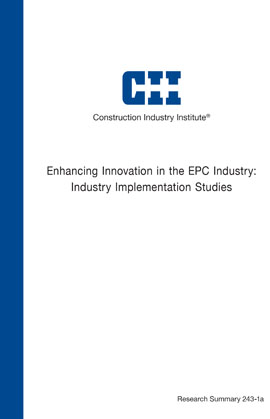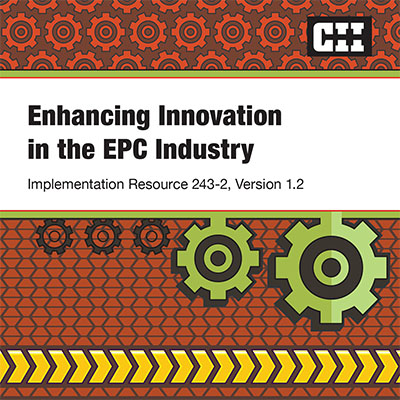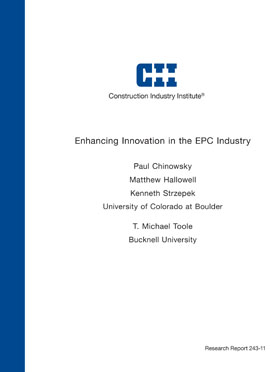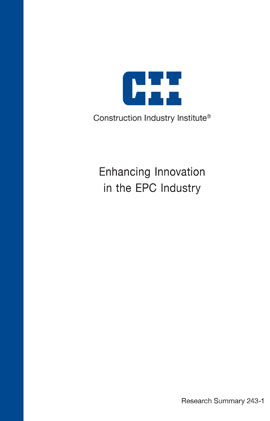
Enhancing Innovation in the EPC Industry: Industry Implementation Studies
This report summarizes the Phase II research on innovation performed by RT 243—the work performed and the data collected during the team’s one-year extension period. While the research methodology, data, and conclusions are new, the report summarizes some of the literature from the first research summary. This second summary will ensure that the reader understands the body of literature on the importance of innovation in all industries.
For decades, EPC organizations have acknowledged that innovation is important but have pointed at a plethora of external factors that have kept them from being innovative. But EPC organizations can no longer afford to ignore opportunities for innovation, given the volatility of the global market, the ever-increasing complexity of capital projects, and the emerging realities of the construction workforce. CII members who continue to focus solely on achieving short-term project goals at the expense of long-term capabilities for managing innovation and change will find themselves following the same path of the U.S. shipbuilding industry: decreasing productivity, decreasing profit margins, and decreasing market share.
The findings presented in this research summary illustrate the significant opportunity the EPC industry has to improve innovation performance. Taking advantage of this opportunity will depend on the commitment the leaders of EPC organizations make to the following:
- changing the industry’s perspective on innovation from a single-project focus to one that considers project portfolios
- establishing repeatable processes for implementing innovation
- dedicating resources to innovation.
The Innovation Maturity Model (IMM) developed by RT 243 evaluates innovation and makes recommendations for increasing innovation. The findings from the four case studies of organizations that pilot-tested the IMM provide evidence for the following conclusions:
- An EPC organization’s responses to the IMM questions provide a representative characterization of its innovative capacity across several dimensions.
- The IMM’s recommendations are straightforward, clear, and can be integrated with other performance improvement initiatives.
- Implementation of the recommendations leads to improvement in the targeted attributes.
The Phase II results suggest that there is a great level of consistency in the strengths and weaknesses among the four case study firms. Moreover, the overall conclusion of both phases of this research is that enhancing innovation is an achievable goal for any EPC organization. However, every organization must challenge its existing assumptions regarding specific areas of operations. For most organizations, the following five sets of strategic actions should be aggressively pursued:
- Build a learning culture. A key element of fostering innovation is building a learning environment in which every member of the organization can embrace the core value of continually acquiring new knowledge.
- Focus on the customer. Continuous innovation must be viewed as a means to achieve continuous improvement and better meeting the changing needs of customers.
- Establish supportive processes. Management must establish processes that encourage and reward innovative ideas; such processes reassure employees that management takes all suggestions for innovations seriously.
- Change the perspective. Organizations must tolerate the inherent risk associated with the introduction of innovative ideas and adopt a multi-project perspective for syndicating innovation risks.
- Focus on specific initiatives. Organizations should focus on the recommendations identified by the Innovation Maturity Model as having the highest potential for increasing innovation within that organization.
The case studies provided concluding effectiveness of the innovation tools and recommendations for improved innovation.
- The IMM data from the four organizations included in this report reveal there is a great level of consistency in the strengths and weaknesses among the case study firms.
- The common areas requiring greater focus are the areas of Resources and Risk Perspective.
- Similarly, the common areas of strength found in the organizations are in the areas of Culture and Learning.
The concluding solutions is that five sets of strategic actions should be aggressively pursued in order to enhance innovation within the EPC organization. (RS243-1a, pp. 27, 29)
- Build a learning culture.
- Focus on the customer.
- Establish processes.
- Change the persepective on risk.
- Focus on specific initiative.



